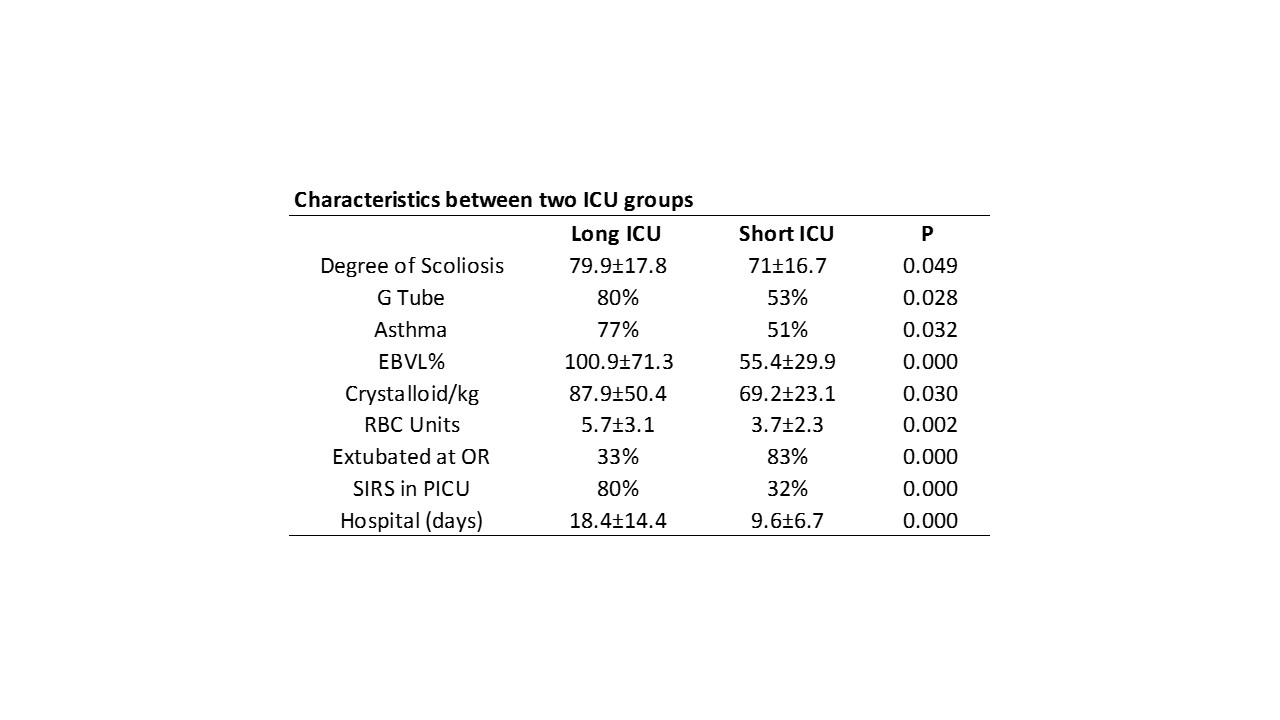NM-365
Predictive factors for length of stay in intensive care unit and hospital in children undergoing scoliosis surgery for neuromuscular scoliosis: A retrospective analysis
Sadacharam K, Brenn B, He Z
Nemours Alfred I duPont Hospital for Children, Wilmington, DE, USA
Factors associated with length of stay in the intensive care unit in children undergoing spinal fusion for neuromuscular scoliosis: A retrospective analysis.
Introduction:
Posterior spinal fusion in patients with neuromuscular scoliosis can be complicated by massive blood loss and fluid shifts, a post-operative course complicated by prolonged mechanical ventilation, deranged coagulation, systemic inflammatory response, leading to prolong stays in the ICU and hospital1,2. Studies in the past have analyzed either preoperative medical conditions or fluid management during surgery as separate determinates of outcome1,2. The primary objective of our study was to determine the wider perioperative factors associated with length of intensive care unit in children undergoing scoliosis surgery for neuromuscular scoliosis.
Methods:
All patients with neuromuscular scoliosis due to spastic cerebral palsy from 2013 to 2016 were identified from our hospitals’ electronic medical record. The predictive factors for length of ICU stay were divided into three broad categories. They included baseline medical conditions, fluid management during surgery and airway management.
The statistical analysis involved primary chi square and t-test to determine explanatory correlations followed by stepwise regressions to determine relative effects.
Results:
The preoperative presence of chronic lung disease, asthma, seizures and emergency room visits were associated with prolonged ICU stay. Patients age, weight, and nutritional status, was not associated with prolonged ICU stay.
Intra-operatively, patients who sustained higher estimated blood volume loss, higher estimated blood loss per kg and received more blood and crystalloid and specifically a higher crystalloid to blood products ratio was associated with prolonged stay in ICU. Extubation in the OR as opposed to patients remaining intubated was highly correlated with a shorter ICU stay.
Initial regression analysis showed that when medical conditions and other intra-operative parameters such as EBVL were controlled, extubation in OR independently and significantly predicted ICU stay (P=0.014, odds ratio=0.162). Therefore, extubation in OR reduced the odds to have long ICU stay by 6.17 fold (=1/0.162).
Discussion:
The results of our study indicates that in addition to the chronic complex medical condition, both the quality of fluid management and ability to extubate the patient in the operating room had a significant impact on the length of ICU stay. Extubation in the OR was found to have strongest correlation with the shortest stay in the ICU.
References:
1. Barsdorf AI et al. Scoliosis Surgery in Children with Neuromuscular Disease Findings from the US National Inpatient Sample, 1997 to 2003. Arch Neurol. 2010; 67(2):231–235
2. Berry JG et al. Co morbidities and complications of spinal fusion for scoliosis. Pediatrics 2017;139(3): doi: 10.1542/peds.2016-2574
Top












